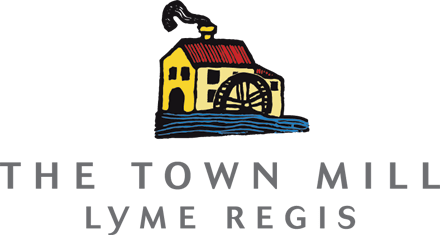The Town Mill Hydro-Electric System
Making ‘green’ electricity
The Town Mill’s hydro-electric system generates AC electricity using the River Lim, our renewable resource. This enables us to make more efficient use of the water that already drives the waterwheel and millstones of this old flour mill that dates from 1340. Some of the electricity generated is used in the Town Mill, whilst the rest is sold into the National Grid.
Planning the project
In 2004, in response to Government energy policies that encourage electricity generation from renewable resources to reduce national CO2 emissions (Kyoto targets), the Town Mill Trustees began to investigate using water from the River Lim to produce ‘green’ electricity. A Feasibility Study carried out in 2005 showed that a micro hydro-electric system would be viable and would not affect the mill’s traditional flour-making capability.
Funding the project
Funding was obtained from Clearskies Renewable Energy Grants, the EDF Energy Green Fund and the Town Mill Trust. These grants enabled the Mill Trustees in 2006 to appoint HydroGeneration Ltd to design and install a micro hydro-electric system for the mill. The total cost of the system was £59,000.
Designing for a Listed Building
The system was designed to fit into the disused wheel pit on the outside of the north wall of the mill building, which is a listed structure. This design solution avoided any structural alterations to the listed building. The location also provides easy access to the water supply from the leat (mill stream) and its discharge into the existing tailrace, already in use for the waterwheel.
How the system works
Water from the leat is collected in a header tank and then fed through a penstock (feed pipe) to drive a water turbine. The water is returned to the river through the draft tube (exhaust). The rotating water turbine is then used to drive an induction generator through a pulley and belt system to generate our ‘green’ electricity. The system is fully automatic and operates round the clock.
Technical facts about the hydro-electric system
The heart of the system is a German-built Ossberger cross-flow water turbine fed by a 4.03 metre head of water, average flow rate 0.24m3/s, giving a maximum power output of 7.07kVA. The turbine drives a Brook Crompton induction generator connected for three-phase operation. The hydro system is controlled by a G83-standard digital control system, with connection to the National Grid through an approved export meter. It is estimated the system will produce about 32,000kW annually, with CO2 savings of about 13 tons annually
Formal opening
The hydro-electric system was officially opened on 1st March 2007. Children from three local schools – The Woodroffe School, St Michael’s Primary School and Mrs Ethelston’s Primary School – operated two sluices to direct river water into the hydro system before the water turbine was switched on to start producing our ‘green’ electricity.
History almost repeated
The mill had used its waterpower to produce DC electricity in the 1930s, but had to take out the waterwheel in order to do it. That DC system was removed in 1948 after the National Grid started operating with AC electricity. Now, some sixty years later, the mill is back in the business of making electricity, whilst still using the re-installed waterwheel to make traditional stone-ground flour.




